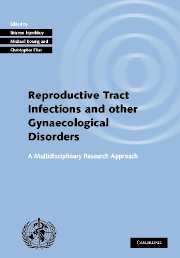 Investigating Reproductive Tract Infections and Other Gynaecological Disorders
Investigating Reproductive Tract Infections and Other Gynaecological Disorders Book contents
- Frontmatter
- Contents
- List of contributors
- Foreword by Paul F.A. Van Look
- Acknowledgements
- 1 Introduction and overview
- 2 Defining reproductive tract infections and other gynaecological morbidities
- 3 The social context of gynaecological morbidity: correlates, consequences and health seeking behaviour
- 4 Reproductive health: men's roles and men's rights
- 5 Study design for the measurement of gynaecological morbidity
- 6 Alternatives to community-based study designs for research on women's gynaecological morbidity
- 7 Community interaction in studies of gynaecological morbidity: experiences in Egypt, India and Uganda
- 8 Definitions of clinically diagnosed gynaecological morbidity resulting from reproductive tract infection
- 9 Laboratory tests for the detection of reproductive tract infections
- 10 Laboratory methods for the diagnosis of reproductive tract infections and selected conditions in population-based studies
- 11 The value of the imperfect: the contribution of interview surveys to the study of gynaecological ill health
- 12 Qualitative methods in gynaecological morbidity research
- 13 Integrating qualitative and quantitative methods in research on reproductive health
- 14 Interpreting results from different sources of data
- 15 Turning research into action
- Appendix A Notes on contributors
- Index
12 - Qualitative methods in gynaecological morbidity research
Published online by Cambridge University Press: 07 December 2009
- Frontmatter
- Contents
- List of contributors
- Foreword by Paul F.A. Van Look
- Acknowledgements
- 1 Introduction and overview
- 2 Defining reproductive tract infections and other gynaecological morbidities
- 3 The social context of gynaecological morbidity: correlates, consequences and health seeking behaviour
- 4 Reproductive health: men's roles and men's rights
- 5 Study design for the measurement of gynaecological morbidity
- 6 Alternatives to community-based study designs for research on women's gynaecological morbidity
- 7 Community interaction in studies of gynaecological morbidity: experiences in Egypt, India and Uganda
- 8 Definitions of clinically diagnosed gynaecological morbidity resulting from reproductive tract infection
- 9 Laboratory tests for the detection of reproductive tract infections
- 10 Laboratory methods for the diagnosis of reproductive tract infections and selected conditions in population-based studies
- 11 The value of the imperfect: the contribution of interview surveys to the study of gynaecological ill health
- 12 Qualitative methods in gynaecological morbidity research
- 13 Integrating qualitative and quantitative methods in research on reproductive health
- 14 Interpreting results from different sources of data
- 15 Turning research into action
- Appendix A Notes on contributors
- Index
Summary
Initial community-based studies in the late 1980s and early 1990s that explored the issue of gynaecological morbidity focused mainly on the clinical assessment of prevalence (Bang et al., 1989; Younis, Khattab and Zurayk, 1993). These early studies faced several methodological challenges in assessing valid prevalence figures due to the sensitive nature of gynaecological morbidity (Koenig et al., 1998; Population Council, 1996). A few studies tested the predictive value of symptoms, such as vaginal discharge, for reproductive tract infections (Bulut et al., 1995; Zurayk and Khattab, 1995). Others tested algorithms as a tool for the diagnosis and management of reproductive tract infections (e.g. Vuylsteke et al., 1993). Still others moved beyond prevalence studies and used qualitative methodological approaches to explore women's perceptions of reproductive tract infections. These methods enabled researchers to explore women's perceptions of the gynaecological problems they encounter in terms of etiology, symptoms, and to some degree the severity of illnesses and health seeking behaviours (Gittelsohn et al., 1994; Oomman, 1996). In spite of a decade of research in the field, several dimensions of gynaecological morbidity remain relatively unexplored and could be more comprehensively investigated using a qualitative research approach. The social, behavioural and biomedical determinants, including sexual and reproductive health-related behaviours and men's roles in women's health, require further elucidation. Similarly, the consequences of gynaecological morbidity, including health seeking behaviour and the impact of morbidity on women's physical and mental health, have not been well described.
- Type
- Chapter
- Information
- Investigating Reproductive Tract Infections and Other Gynaecological DisordersA Multidisciplinary Research Approach, pp. 322 - 359Publisher: Cambridge University PressPrint publication year: 2003
